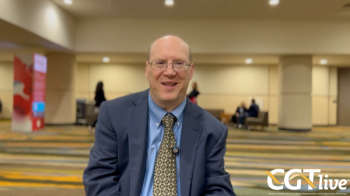
Dual-Targeted CAR T Therapy Efficacious in Relapsed/Refractory B-Cell Malignancies
The phase 1 study met its primary endpoints, with 97% of the CAR T-cell therapies reaching the protocol-specified dose and no dose-limiting toxicities during dose escalation.
This content originally appeared on our sister site,
Treatment with the bispecific CAR T-cell therapy, CD19-22.BB.z-CAR, that targets both CD19 and CD22 was well-tolerated in adult patients with relapsed/refractory, CD19-positive B-cell acute lymphoblastic leukemia (B-ALL) and
These findings, from a phase 1 study (NCT03233854), were published in Nature Medicine. The data showed that 97% of treatments reached the protocol-specified dose, and no dose-limiting toxicities (DLTs) occurred during dose escalation, meeting the primary end points of the study.
Moreover, in the B-ALL cohort (n = 17), the objective response rate (ORR) was 100%; 14 patients had a complete response (CR; 82%) and 3 had partial responses (PRs). One patient’s PR improved to CR 6 months after infusion, leading to a minimal residual disease–negative CR rate of 88%. In the LBCL cohort (n = 21), the ORR was 62% (95% CI, 38%-82%), and the CR rate was 29% (95% CI, 11%-52%).
“Using a bispecific CAR capable of simultaneously recognizing CD22 and CD19, we demonstrated safety and impressive clinical activity in B-ALL,” Jay Y. Spiegel, MD, a hematology fellow at Stanford University, and coauthors, wrote in the study publication.
READ MORE:
More than 50% of patients who receive CD19-directed CAR T-cell therapy will develop progressive disease. To understand the association between CD19 antigen expression and relapse, investigators measured CD19 expression at baseline and at disease progression in patients who received treatment with the CD19-directed CAR T-cell therapy, axicabtagene ciloleucel (axi-cel; Yescarta) at Stanford.
The results showed that 10 of the 16 patients with LBCL who developed progressive disease after treatment with axi-cel had no or low CD19 expression. Moreover, lower surface CD19 density pretreatment was associated with progressive disease (P = .03).
As a potential way of overcoming antigen escape and subsequent relapse, investigators subsequently evaluated a dual CD19- and CD22-targeted CAR T-cell therapy in patients with relapsed/refractory B-ALL and LBCL.
Eligible patients had relapsed/refractory disease following at least 2 prior lines of therapy and had measurable disease that expressed CD19.
Patients received conditioning chemotherapy followed by CAR T-cell infusion at 2 dose levels: 1 × 106 CAR+ cells kg−1 (dose level 1) and 3 × 106 CAR+ cells kg−1 (dose level 2) using a 3 + 3 dose-escalation phase that enrolled patients with LBCL and B-ALL in one cohort.
The two disease-specific expansion cohorts received the recommended phase 2 dose of 3 × 106 CAR T cells kg−1 (dose level 2).
The primary end points of the study were manufacturing feasibility and safety; efficacy served as a secondary end point.
In the B-ALL cohort, the median age was 47 years (range, 26-68); 71% of patients had progressive disease following allogeneic hematopoietic cell transplantation, 65% had prior CD19-directed therapy, and 29% had prior CD22-directed therapy. Sixty-three percent of patients had prior central nervous system (CNS) involvement and 12% had active CNS disease at the time of enrollment.
In the LBCL cohort, the median age was 69 years (range, 25-78); 15 patients had c-MYC and BCL2 expression, 3 had high-grade B-cell lymphoma with c-MYC and BCL2 translocation and/or BCL6 translocation, and 4 had prior autologous stem cell transplant.
Additional results showed that in the B-ALL cohort, at a median follow-up of 9.3 months (95% CI, 7.2-NE), the median overall survival (OS) was 11.8 months (95% CI, 5.5-not estimable [NE]), and the median PFS was 5.8 months (95% CI, 2.6-NE). Two patients proceeded to allogeneic stem cell transplant in CR and are in ongoing remission.
In the LBCL cohort, 5 of 13 responders had an improved response from month 1 to month 3 following infusion. At a median follow-up of 10 months (95% CI, 8.7-21.5), the median OS was 22.5 months (95% CI, 8.3-NE), and the median PFS was 3.2 months (95% CI, 1.2-5.5).
Among patients with LBCL who received the recommended phase 2 dose (n = 15), the ORR and CR rate at 3 months was 40% (95% CI, 16%-68%) and 33% (95% CI, 12%-62%), respectively.
Notably, the absence or low expression of CD19 was found in 5 of 10 (50%) patients with relapsed B-ALL. In patients with LBCL, 4 of 14 (29%) relapses were associated with no or low CD19 expression but were not associated with an absence or low expression of CD22.
“The observed relapses with CD19 [negativity and loss]and maintained CD22 expression could be due to reduced potency of the bispecific receptor toward CD22 vs CD19,” wrote the authors.
Additionally, the CD19- and CD22-directed CAR T-cell therapy demonstrated reduced cytokine production when stimulated with CD22 vs CD19.
“The reduced potency of the CD22 [single-chain variable fragment] provides a mechanism for relapse with CD19 [negative and low] disease with preserved CD22 expression in the population studied here,” wrote the authors.
Regarding toxicity, 1 DLT occurred during the trial. Any-grade cytokine release syndrome (CRS) occurred in 29 patients (76%), with a median onset of 1 day after infusion (range, 0-8) and lasted a median of 4 days (range, 1-12).
Grade 3 or greater CRS occurred in 2 patients (5%). Neurological toxicity occurred in 14 patients (37%; n = 9 with LBCL; n = 5 with B-ALL); 4 patients experienced grade 3 or greater neurotoxicity. The onset of neurotoxicity occurred a median of 5 days after infusion (range, 3-9) and lasted a median of 4 days (range, 1-11).
CRS and neurotoxicity were treated per institutional guidelines, with 15 patients (39%) receiving at least 1 dose of tocilizumab (Actemra; range, 1-3) and 45% of patients receiving corticosteroids.
All cases of CRS and neurotoxicity resolved.
Two patients had evidence of macrophage activation syndrome with hyperferritinemia and hypofibrinogenemia with grade 3 or greater neurotoxicity and received high-dose corticosteroids and anakinra.
“Future work is needed to optimize multi-specific targeting by CAR T cells to improve the efficacy of this class of therapeutics both in B-cell malignancies and other solid and liquid cancers,” concluded the authors.
REFERENCE
Spiegel JY, Patel S, Miklos DB, et al. CAR T cells with dual targeting of CD19 and CD22 in adult patients with recurrent or refractory B cell malignancies: a phase 1 trial. Nat Med. 2021;27:1419-1432. doi.org/10.1038/s41591-021-01436-0
Newsletter
Stay at the forefront of cutting-edge science with CGT—your direct line to expert insights, breakthrough data, and real-time coverage of the latest advancements in cell and gene therapy.











































